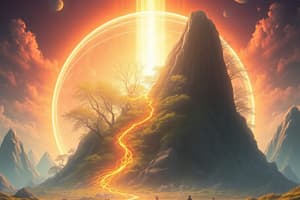Podcast
Questions and Answers
What is the primary function of decomposers in an ecosystem?
What is the primary function of decomposers in an ecosystem?
- To regulate the populations of producers and consumers
- To produce their own food through photosynthesis
- To break down dead organic matter and recycle nutrients (correct)
- To consume other organisms to obtain energy
Which of the following is a consequence of the 10% rule in energy flow through ecosystems?
Which of the following is a consequence of the 10% rule in energy flow through ecosystems?
- Most energy is lost as heat between trophic levels
- Energy is transferred with 100% efficiency between trophic levels
- Energy is only transferred from producers to consumers
- Only a small portion of energy is available to higher trophic levels (correct)
What is the primary mechanism by which nitrogen is made available to plants in the nitrogen cycle?
What is the primary mechanism by which nitrogen is made available to plants in the nitrogen cycle?
- Denitrification
- Nitrogen fixation (correct)
- Nitrification
- Ammonification
Which of the following is a consequence of human activities on the carbon cycle?
Which of the following is a consequence of human activities on the carbon cycle?
What is the primary driver of the water cycle?
What is the primary driver of the water cycle?
What is the primary advantage of stratified sampling in ecological studies?
What is the primary advantage of stratified sampling in ecological studies?
Which of the following is a type of biodiversity?
Which of the following is a type of biodiversity?
What is the primary consequence of over-extraction of groundwater?
What is the primary consequence of over-extraction of groundwater?
What is the primary function of producers in an ecosystem?
What is the primary function of producers in an ecosystem?
Which of the following is an ecosystem service supported by biodiversity?
Which of the following is an ecosystem service supported by biodiversity?
Flashcards are hidden until you start studying
Study Notes
Ecosystems
- Definition: A community of living organisms (biotic factors) and non-living components (abiotic factors) interacting with each other in a specific environment.
- Key components:
- Producers (plants, algae): make own food through photosynthesis
- Consumers (herbivores, carnivores, omnivores): obtain energy by consuming other organisms
- Decomposers (bacteria, fungi): break down dead organic matter
- Energy flow:
- From producers to consumers through food chains
- Energy lost at each trophic level (10% rule)
- Nutrient cycling:
- Nutrients recycled between biotic and abiotic factors
Biodiversity
- Definition: Variety of species, genes, and ecosystems in an environment
- Types of biodiversity:
- Species diversity: number of different species
- Genetic diversity: variation within a species
- Ecosystem diversity: variety of ecosystems
- Importance of biodiversity:
- Maintains ecosystem services (e.g., pollination, pest control)
- Supports food security and medicine
- Enhances ecosystem resilience
Nitrogen Cycle
- Processes:
- Nitrogen fixation: conversion of atmospheric nitrogen (N2) to ammonia (NH3) by bacteria
- Ammonification: conversion of ammonia to ammonium ions (NH4+)
- Nitrification: conversion of ammonium ions to nitrate ions (NO3-)
- Denitrification: conversion of nitrate ions back to atmospheric nitrogen
- Human impact:
- Overuse of fertilizers leads to eutrophication
- Nitrogen oxides (NOx) contribute to air pollution
Carbon Cycle
- Processes:
- Photosynthesis: conversion of CO2 to organic compounds by plants
- Respiration: release of CO2 from cells during energy production
- Decomposition: breakdown of organic matter, releasing CO2
- Fossil fuel formation: long-term storage of carbon in fossil fuels
- Human impact:
- Burning fossil fuels releases CO2, contributing to climate change
- Deforestation reduces carbon sequestration
Water Cycle
- Processes:
- Evaporation: water vapor formation from oceans, lakes, and rivers
- Condensation: water vapor conversion to liquid water
- Precipitation: water falling to the ground as rain, snow, or hail
- Infiltration: water absorption into soil
- Runoff: water flowing over land into bodies of water
- Human impact:
- Over-extraction of groundwater leads to water scarcity
- Pollution of water sources affects human health and ecosystems
Sampling
- Definition: Selecting a subset of individuals or data from a larger population
- Types of sampling:
- Random sampling: every individual has an equal chance of selection
- Systematic sampling: selecting individuals at regular intervals
- Stratified sampling: dividing the population into subgroups and sampling from each
- Importance of sampling:
- Allows for representative data collection
- Reduces costs and time required for data collection
- Enables generalization of results to the larger population
Ecosystems
- Ecosystems consist of biotic factors (living organisms) and abiotic factors (non-living components) interacting in a specific environment.
- Producers (plants, algae) make their own food through photosynthesis.
- Consumers (herbivores, carnivores, omnivores) obtain energy by consuming other organisms.
- Decomposers (bacteria, fungi) break down dead organic matter.
- Energy flows from producers to consumers through food chains, with a 10% energy loss at each trophic level.
- Nutrients are recycled between biotic and abiotic factors.
Biodiversity
- Biodiversity is the variety of species, genes, and ecosystems in an environment.
- Species diversity refers to the number of different species.
- Genetic diversity refers to the variation within a species.
- Ecosystem diversity refers to the variety of ecosystems.
- Biodiversity maintains ecosystem services, supports food security and medicine, and enhances ecosystem resilience.
Nitrogen Cycle
- Nitrogen fixation converts atmospheric nitrogen (N2) to ammonia (NH3) by bacteria.
- Ammonification converts ammonia to ammonium ions (NH4+).
- Nitrification converts ammonium ions to nitrate ions (NO3-).
- Denitrification converts nitrate ions back to atmospheric nitrogen.
- Overuse of fertilizers leads to eutrophication, and nitrogen oxides (NOx) contribute to air pollution.
Carbon Cycle
- Photosynthesis converts CO2 to organic compounds by plants.
- Respiration releases CO2 from cells during energy production.
- Decomposition breaks down organic matter, releasing CO2.
- Fossil fuel formation stores carbon in fossil fuels for long periods.
- Burning fossil fuels releases CO2, contributing to climate change.
- Deforestation reduces carbon sequestration.
Water Cycle
- Evaporation forms water vapor from oceans, lakes, and rivers.
- Condensation converts water vapor to liquid water.
- Precipitation involves water falling to the ground as rain, snow, or hail.
- Infiltration absorbs water into soil.
- Runoff involves water flowing over land into bodies of water.
- Over-extraction of groundwater leads to water scarcity, and pollution of water sources affects human health and ecosystems.
Sampling
- Sampling involves selecting a subset of individuals or data from a larger population.
- Random sampling gives every individual an equal chance of selection.
- Systematic sampling involves selecting individuals at regular intervals.
- Stratified sampling divides the population into subgroups and samples from each.
- Sampling allows for representative data collection, reduces costs and time, and enables generalization of results to the larger population.
Studying That Suits You
Use AI to generate personalized quizzes and flashcards to suit your learning preferences.




